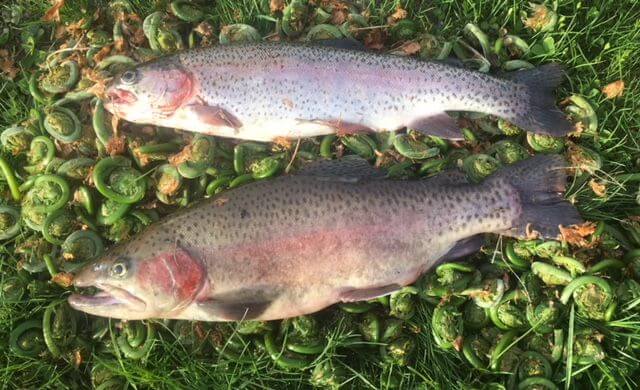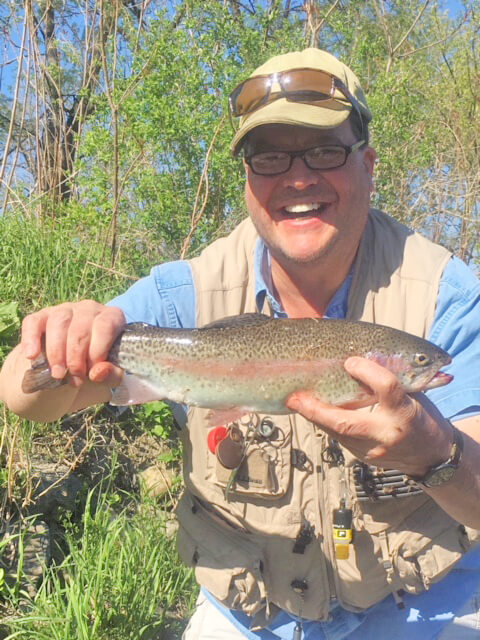What is worth this degree of peril? Trophy rainbows!

My old Toyota truck rolls merrily down the highway on a late afternoon. The sun is shining brightly. The temperature is at a perfect setting—no one complains that it is too cool or too warm. It’s perfect. It’s one of those days that we bank on all winter.
I’ve got my friend Doug with me, and we’re headed to the trophy-trout section of the mighty Winooski.
Yesterday I picked about three pounds of snappy green fiddleheads along the banks. When I saw the invasive Japanese knotweed growing along the shoreline, I could see how most people would overlook this spot because it looks daunting to navigate through the hollow shoots that seem to grab at your ankles and wrestle you to the ground. This is particularly challenging when carrying a rod, tackle box, creel and a bucket of aerated minnows from George Leclair’s Big River Bait & Tackle in Hinesburg.

At one point I try to deftly leap from one boulder to the next, and down I go. Ouch. But even amid the chaos of the moment, thinking about where I will land and how hard I will hit, like any good fisherman, my concern is for the minnows. The bucket hits the side of one of the boulders and water and minnows begin to spill out. I grab the bucket with my free hand (the third one that I’m not using to break my fall) and rescue half of the small-medium shiners and half of the water. An appropriate expletive slips from my mouth, and Doug asks, “Are you okay?” “Good enough,” I reply.
We set up our tackle on the steep embankment, balancing on large fill rocks that seem steady but always challenge my perception of safe footing.
What is worth this degree of peril? Trophy rainbows!
I rig a minnow harness with the customized double hook that an old timer once showed me and pinch a tin split-shot 18 inches above the bait. With my left hand outstretched for balance, I twist my torso to the right with my rod hand behind me and whip the bait upstream at a 30-degree angle to the current. I let it sink and bounce along the bottom, reeling a tiny bit every few seconds to add swimming action and to make it look like a crippled baitfish.
Three quarters of the way down the current, in a deep hole, a big fish rises to look at the bait. I feel a gentle—very gentle—bite and reel the bait forward just a little as if the minnow were trying to escape its fate. The big fish cannot contain its instinct and strikes violently, inhaling the silvery prey.
The rod snaps down abruptly, and the game is on! The rod blank throbs as the bruiser throws his shoulders into the fight. When he gets near the bank I am waiting, net in hand. But when he sees the wooden net come swooping toward him he turns his back and sprints away into the deep, tugging on the mere four-pound line that ties our spirits together.
The drag on the reel screams a high-pitched sound like that of a bumblebee on steroids. I let him run, keeping just enough pressure on him to tire him out. He begins to show signs of resignation, and I reel him back to the shore.
I reach down and scoop his head over the wooden barrel of the net. He’s in!
I lift him up to admire his glorious colors—pink, red, sage green and a lot of shiny silver. In the sunlight he seems to glow like an angel form that lives in another world.
I kiss his head and thank our Great Spirit for connecting us today. Tonight he will be served on a bed of fresh fiddleheads, sautéed in butter and garlic. And tomorrow we will share the memory of our moment in the early spring sun.
Bradley Carleton is executive director of Sacred Hunter, a nonprofit that seeks to educate the public on the spiritual connection of man to nature and raises funds for Traditions Outdoor Mentoring, which mentors at-risk young men in outdoor pursuits.

